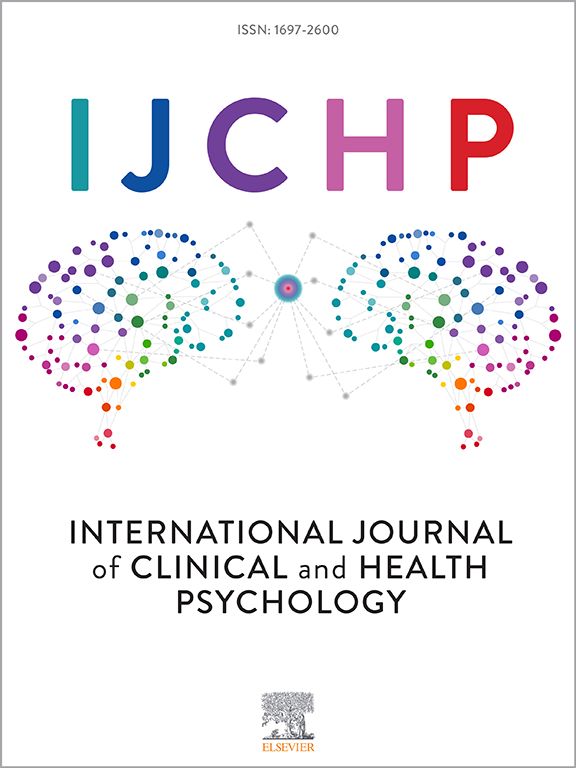Altered resting-state functional connectivity in individuals at risk for Alzheimer’s disease: a longitudinal study
IF 4.4
1区 心理学
Q1 PSYCHOLOGY, CLINICAL
International Journal of Clinical and Health Psychology
Pub Date : 2025-04-01
DOI:10.1016/j.ijchp.2025.100588
引用次数: 0
Abstract
Background
Resting-state functional connectivity magnetic resonance imaging (rs-fMRI) is a sensitive tool for detecting early brain changes associated with Alzheimer’s disease, even in its preclinical stages. Amnestic mild cognitive impairment (aMCI) and late-life depression (LLD) are two prevalent conditions in older adults that significantly elevate the risk of cognitive decline and dementia. This study aimed to elucidate the underlying neurobiological substrates by longitudinally identifying and comparing distinct connectivity patterns in aMCI subjects and LLD patients, and by examining the associations between these patterns and clinical measures of cognitive and mood impairments.
Methods
The study included three groups: 26 healthy controls (HCs), 15 individuals with aMCI, and 21 patients with LLD. All participants underwent rs-fMRI and neuropsychological assessments at baseline and at a 2-year follow-up. Functional connectivity was analyzed using a group Independent Component Analysis (ICA) model to investigate both group differences and longitudinal changes over time.
Results
At baseline, individuals with aMCI exhibited reduced functional connectivity in the precuneus, whereas LLD patients showed decreased connectivity in frontal, insular, and postcentral regions alongside increased connectivity in posterior parietal and cuneal cortices. Correlation analyses revealed that lower baseline insular connectivity predicted higher depressive symptoms at follow-up in aMCI subjects. In LLD, reduced baseline precuneus connectivity was associated with better two‐year outcomes in global cognition and long‐term memory.
Conclusions
This study provides evidence of distinct alterations in resting-state functional connectivity in individuals with aMCI and LLD, underscoring region-specific vulnerabilities that may contribute to cognitive decline and depressive symptomatology in older adults.
阿尔茨海默病风险个体静息状态功能连接改变:一项纵向研究
睡眠状态功能连接磁共振成像(rs-fMRI)是一种灵敏的工具,可以检测与阿尔茨海默病相关的早期大脑变化,甚至在其临床前阶段。遗忘性轻度认知障碍(aMCI)和晚年抑郁症(LLD)是老年人中两种普遍存在的疾病,可显著提高认知能力下降和痴呆的风险。本研究旨在通过纵向识别和比较aMCI受试者和LLD患者的不同连接模式,并通过检查这些模式与认知和情绪障碍的临床测量之间的关联,阐明潜在的神经生物学基础。方法将健康对照(hc) 26例、aMCI患者15例、LLD患者21例分为3组。所有参与者在基线和2年随访时均接受了核磁共振成像和神经心理学评估。使用群体独立成分分析(ICA)模型分析功能连通性,以调查群体差异和随时间的纵向变化。结果在基线时,aMCI患者表现出楔前叶功能连通性降低,而LLD患者表现出额叶、岛叶和后中央区域的连通性降低,后顶叶和楔叶皮质的连通性增加。相关分析显示,较低的基线岛连通性预测aMCI受试者随访时较高的抑郁症状。在LLD中,减少的基线楔前叶连通性与更好的2年全球认知和长期记忆结果相关。本研究提供了aMCI和LLD患者静息状态功能连通性明显改变的证据,强调了可能导致老年人认知能力下降和抑郁症状的区域特异性脆弱性。
本文章由计算机程序翻译,如有差异,请以英文原文为准。
求助全文
约1分钟内获得全文
求助全文
来源期刊

International Journal of Clinical and Health Psychology
PSYCHOLOGY, CLINICAL-
CiteScore
10.70
自引率
5.70%
发文量
38
审稿时长
33 days
期刊介绍:
The International Journal of Clinical and Health Psychology is dedicated to publishing manuscripts with a strong emphasis on both basic and applied research, encompassing experimental, clinical, and theoretical contributions that advance the fields of Clinical and Health Psychology. With a focus on four core domains—clinical psychology and psychotherapy, psychopathology, health psychology, and clinical neurosciences—the IJCHP seeks to provide a comprehensive platform for scholarly discourse and innovation. The journal accepts Original Articles (empirical studies) and Review Articles. Manuscripts submitted to IJCHP should be original and not previously published or under consideration elsewhere. All signing authors must unanimously agree on the submitted version of the manuscript. By submitting their work, authors agree to transfer their copyrights to the Journal for the duration of the editorial process.
 求助内容:
求助内容: 应助结果提醒方式:
应助结果提醒方式:


